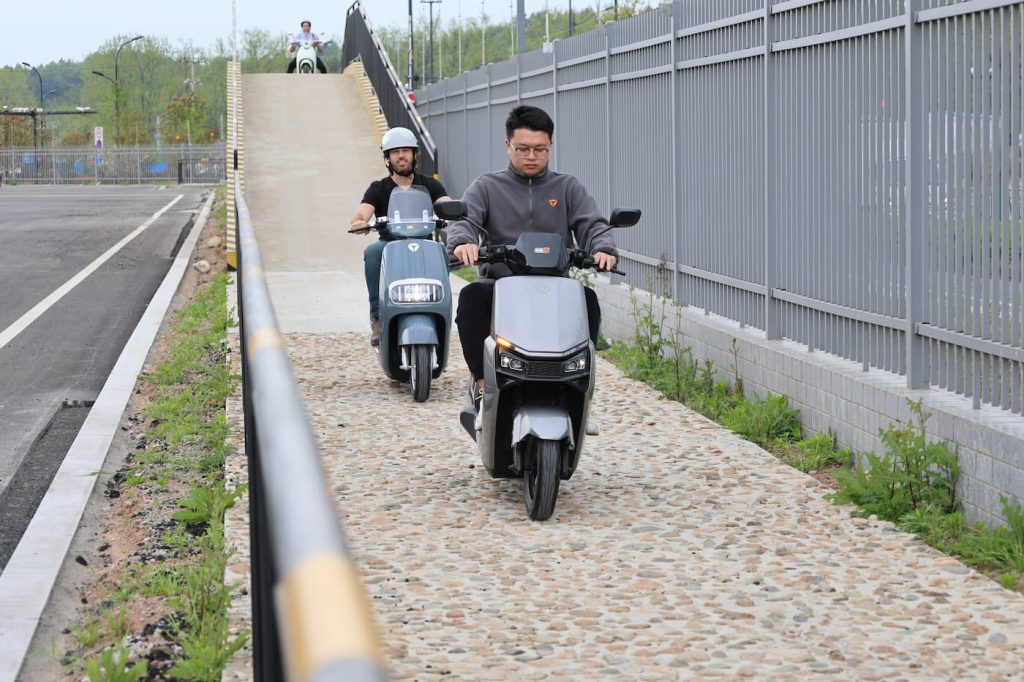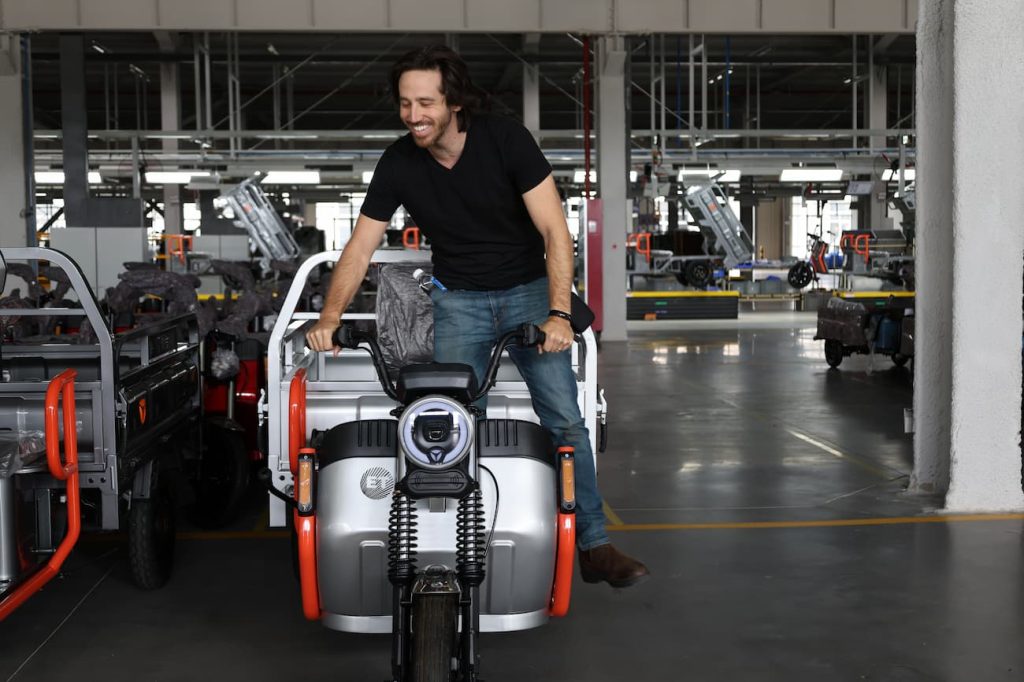I recently took a trip to China to visit Yadea’s sprawling Anhui factory, which is just one of the company’s eight worldwide manufacturing centers. Together, they produced over 16 million electric vehicles last year, more than all of the big electric car manufacturers combined.
Since these pint-sized electric vehicles are so massively popular, I wanted to go there and try them myself and see what all the fuss was about. As it turns out, there’s a good reason why these are the best-selling little EVs in the world! And now that several of the models are coming to Europe and North America, Yadea’s lineup is looking even more interesting.
This is Part II of this series, which follows my visit to the manufacturing facilities inside Yadea’s Anhui factory. To see how these e-bikes, e-scooters, e-three wheelers, and other popular micromobility vehicles are made, check out Part I of the series here.
If you’ve already checked it out (or you just want to jump right into the test drives), then keep on reading below. Or check out my video here, which covers both the factory tour and the test drives.
After finishing up the factory tour, where I had the chance to see how and where Yadea’s vehicles are produced, I was fortunate enough to spend the rest of the day test-driving many of the vehicles I had just watched rolling across the assembly line.
At the company’s test track, Yadea’s team prepared for me a lineup of electric mopeds, electric kickscooters, electric bicycles, and a couple really fun-looking electric three-wheelers.
I call it a test track, but I think a more accurate term would be torture track. The course starts with a dive into a shallow water pool to simulate riding through flooded roads (yes, what feels like it should be the grand finale is just the start!). A steep exit ramp from the standing water pool takes you across a washboard section simulating rutted-out roads. Then it’s uphill from there, literally, as a massive ramp takes you up and then back down the other side, launching you immediately into a cobblestone section. From there, you hit not just one but 26 speed bumps in rapid succession. It’s an HOA president’s fantasy come to life.
And if that wasn’t enough to cover just about every torturous terrain possible (and scramble your brain a bit from the few dozen speed bumps you just traversed), the course finishes off with a coup de grâce of a loose gravel section. It’s surely there to test the bikes’ abilities on gravel roads, but it’s so deep that it’s less like riding on a gravel road and more like riding on a gravel pit, so it also ends up being a test of your own riding skills.
Oh, and the entire scooter obstacle course is walled in by a fence, meaning once you’ve started, you aren’t getting back out until you’ve finished the course. Apparently, you either clear it or die trying.




I am proud to say that I completed the torture test on a couple of the electric mopeds as well as on their Cocoa electric utility bike, both of which were more than up to the task.
The moped climbed the ramp surprisingly quickly and then gave me a chance to test out the regenerative braking on the steep descent. On the descent I didn’t even need to touch the brake levers.


I declined to take the three-wheelers down the torture test course. Still, I saw multiple other Yadea three-wheelers run the gauntlet with Yadea employees at the helm since it’s part of the standard verification testing for vehicles to ensure they can handle such varied terrain. They were either braver than me, or they do this so many times a day that it’s a cakewalk for them at this point.
When it came time to test the standing scooters, I found three different full-suspension models laid out in front of me. The Yadea Artist was the lightest, yet still impressively powerful with a 600W motor. Two larger and progressively higher performance models, the Yadea Elite Max and Yadea Elite Prime, have even longer travel suspension, larger batteries, and faster speeds.
But they all still share many features like convenient folding designs, built-in handlebar turn signals that face both forwards and rearwards, and companion apps for more settings and control.

I was curious how well the scooters could handle the torture test, but wasn’t sure if I had the skills to make it myself. That’s when Joy, who comes from the scooter marketing division, volunteered to simultaneously emasculate me and show me how it was done. For reference, picture the adorable 90-lb-looking Joy flying down the course as she somehow sailed over that long gravel pit without a care in the world. Not wanting to lose face, I tried to recreate it afterward, yet I definitely had to put a foot down twice across the same gravel section. Looks like I’ll be taking off-road riding tips from Joy for now on.
Needing to save face, I told Joy I could surely tackle that massive ramp on the Elite Prime scooter. It’s the most powerful of the three full-suspension scooters, and perhaps worried about my safety, she showed me how to do it first. She flew up the ramp even more carefree than when she traversed the gravel pit, though I noticed she slowed near the top and put a foot down before leveling out.
Aha! My turn to show her up! I took the bars and went full speed into that ramp, hoping to finally win at something here. And as I shot up that massive ramp, I soon realized why she had pulled her punches at the end. The scooter is so powerful that I just kept going! I flew over the top of the ramp, continued across the tabletop, and headed down the other side before I managed to bring myself to a wide-eyed stop. Fortunately, no one saw my near launch into orbit as I was safely hidden on the far side of the ramp, giving me a chance to steady my heartbeat and ride back down as if everything had gone according to plan.
The takeaway point is this: these electric scooters can handle just about anything, but the real question is whether YOU can handle it.

The Cocoa electric utility bike was next on my list, and I instantly fell in love with the design. I like bright colors, and it’s cool to see the Yadea orange integrated into the racks, which are included as part of the bike and, fortunately, not held back behind a paywall as add-on accessories.
Yadea will also have several other accessories available in the future as they expand their line of cargo carriers, child seats, and other utility-oriented optional accessories. In the meantime, though, they’ve designed the bike to be fairly universal so that riders can either make their own add-ons or use third-party accessories as well.

The bike also rides beautifully, even without suspension. It’s got a huge, 5.5 inch color screen and offers a rear passenger bench option for carrying a second rider with you. I know many people won’t look at an e-bike without suspension, but I can tell you that the large tires helped it handle everything along the torture test quite well, at least until hitting the speed bump section too fast. That resulted in a rather rough ride, serving as a good reminder to slow down the next time you hit a series of 26 speed bumps in a row.
With a torque sensor, 7-speed drivetrain, and hydraulic disc brakes, the Yadea Cocoa has most of what most American riders are looking for. The 500W motor peaks at 740W, putting it near the upper limit for Class 2 e-bikes, even if it’s not exceeding the limit like many US-based electric bikes. It certainly felt plenty powerful to me, and I had no problem climbing the steep hill in the proving grounds’ torture test course.

The last vehicles to test were also the largest. Yadea had two of their three-wheelers set up for me to test. The first was the Yadea C16 electric trike, which comes in either a covered or open-top configuration. I tested the covered version, which felt essentially like a golf cart. It even started raining a bit, giving me the chance to test out the wipers on the windshield as well.
The motor is only listed as around 1,400 watts, but it’s weirdly powerful. Chinese companies often use the continuous power rating of the motor, while in the US we are used to local companies advertising the more impressive peak wattage. So don’t be fooled by the 1.4 kW rating, the true peak power of this thing is much higher. It was even quite powerful in reverse, so hill climbing in either direction won’t be a problem.
The front seat is basically meant for a single operator, though you could likely fit a small child on there with you. The rear has room for two healthy adults or perhaps three kids if they don’t bicker in close quarters.
The production quality is quite good, with everything having a cute and rounded, bubbly appearance. These types of vehicles are common for grandparents to use in China, often as a way to shuttle kids around or pick them up from daycare. The family-friendly design theme works well and is visible throughout the vehicle, giving it a higher level of approachability. It might look a bit foreign to us as Westerners, but I bet most people would see one on the street and want to give it a test ride – I certainly did!

The second three-wheeler I tested was the ET152 electric cargo tricycle, which is basically the pickup truck of China. These are hugely popular all over rural areas and are commonly seen both on farms for agricultural work, and on the shoulder of major roads in rural areas where they serve a utility role.
This one was loaded down with 15 jugs each carrying 25 liters of water, or around 55 pounds. That’s over 800 pounds of load, which it carried without even noticing since its actual payload capacity is actually 1.5 metric tons, or 3,300 pounds.
To kick things up a notch, I asked some of my new friends to go for a ride with me, getting six more humans worth of weight on the trike, but that barely even got us to half of its rated capacity. To put this into perspective, this electric cargo trike is rated to carry just as much load as an F-150 and more than many smaller pickup trucks in the US.


To put it lightly, I tested a pretty wide range of light electric vehicles at the Yadea factory, and that barely scratched the surface of the various models they offer.
I’m excited to see that more and more of the company’s lineup is starting to enter the European and North American markets. As the world’s largest electric vehicle maker, Yadea is well positioned to leverage its market leader position to combine technological innovations and high-quality manufacturing processes to bring some impressive new EVs to global markets.
As much fun as I had riding the vehicles on display, I can’t wait to see even more of Yadea’s offerings spread around the world.


